Paper-[arXiv 1710.03144]Island Loss for Learning Discriminative Features in Facial Expression
[arXiv 1710.03144]Island Loss for Learning Discriminative Features in Facial Expression
ABSTRACT
作者在CenterLoss的基礎上,提出了一個新的Loss,在關注類別的類內距離的同時,優化類間距離,使得每個類別擁有更大的margin,從而迫使網路能夠學習到更具判別性的特徵。
當前問題
在環境不可控(光照,姿態,遮擋,人物狀態)等條件下,不同表情間的類間距離往往會大於類內距離。同時因為高的類內距離,同一類別的樣本分佈趨勢呈現出了徑向(NormFace中提到的softmax的Scale不變性)
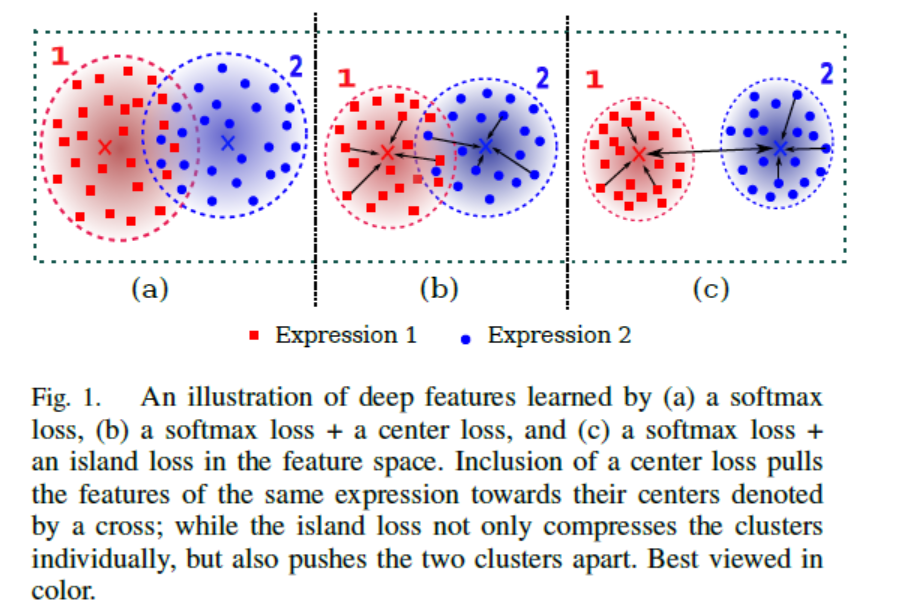
\[ 不同loss情況下類別特徵空間分佈情況 \]
本文貢獻
本文主要有一下貢獻:
- 提出了一個新的loss函式,目的是能夠得到更具判別性的特徵,從而使得類內距離小,類間距離大。
設計了一個機遇IslandLoss的卷積神經網路框架,完成人臉面部表情的識別。
作者在三個資料庫上進行了實驗,(CK+,Oulu-CASIA 和MMI),並且在SFEW的資料庫上進行了驗證。對比與傳統的SoftmaxLoss和CenterLoss,新提出的Loss效果更好。
理論方法
\(softmax loss\):
\[ L = -\frac{1}{N}\sum_{j=1}^{N}{y_ilog{\frac{exp(z_{y_i})}{\sum_{k=1}^{c}{exp(z_k)}}}} \]\(centerLoss\),在softmax的基礎上,新添加了一種loss:
\[ L_c = \frac{1}{2}\sum_{i=1}^{n}||x_i-c_{yi}|| \]
其中,\(yi\)為樣本i的類心特徵向量。因此整體的Loss為
\[ L = L_{softmax} + \lambda L_c \]
反向更新的時候,每個batch內,每個樣本僅僅負責更新該類的類心.\(IslandLoss\) ,在softmax的基礎上,優化類間距離:
\[ L_{island}=L_c+ \lambda_{1} \sum_{c_{j} \in N}\sum_{c_k \in N ,c_k \neq c_j}{\frac{c_k \cdot c_j}{||c_k||_2||c_j||_2}+1} \]
公式看著比較複雜,實際上即每個類心求餘弦距離,+1 使得範圍為0-2,越接近0表示類別差異越大,從而優化Loss即使得類間距離變大。當類別過多時,loss容易溢位.
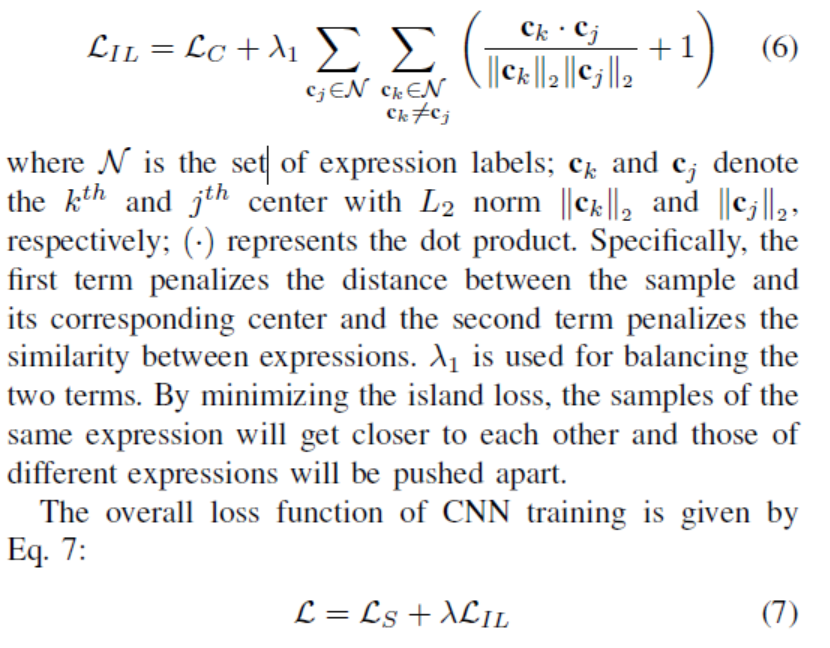
\[ islandloss 前向公式 \]
\[ L = L_{softmax}+ \lambda L_{island} \]
反向更新過程即求導過程,實際簡化為x/||x||的求導,需要注意i==j和i!=j.
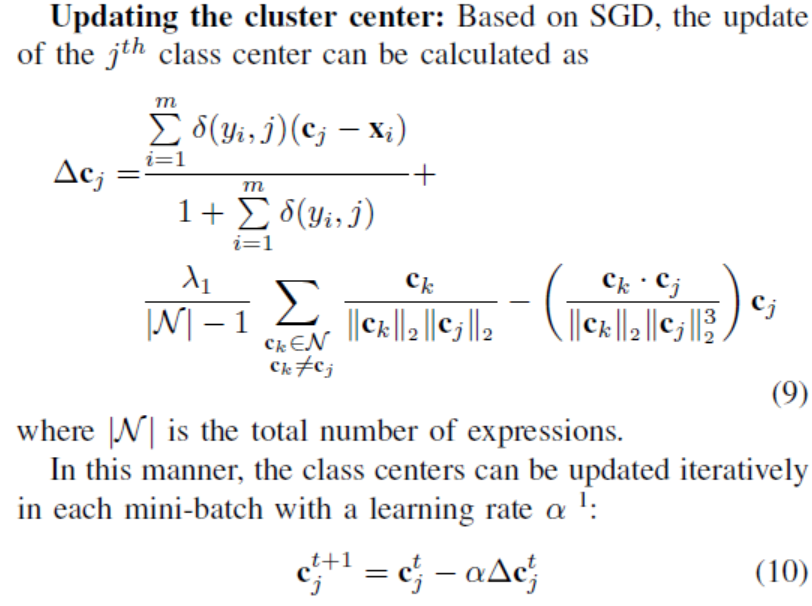
\[ islandloss 反向更新公式 \]

\[ islandLoss層次類心的迭代與更新過程 \]
實驗過程
實驗包含預處理,卷積神經網路超引數。
資料預處理
根據人臉特徵點的位置,以雙眼為中心,進行人臉對齊。人臉影象縮放到60*60,同時,影象cropSize為48*48,影象隨機旋轉-10°~10°,並進行水平flip,從而增加訓練樣本的數量.
卷積神經網路結構
3個卷積層後接Prelu和BN,每一個bn的後面接一個MaxPooling,最終接入兩個全連線層,softmax和Islandloss共同驅動最終的loss,採用sgd+momentum batch_size為300,weight_decay設定為0.05,每個全連線後接dropout層。

\[ 卷積神經網路結構圖\]
實驗結果
作者做了一個簡單的視覺化,並統計了不同loss中特徵類心的距離.
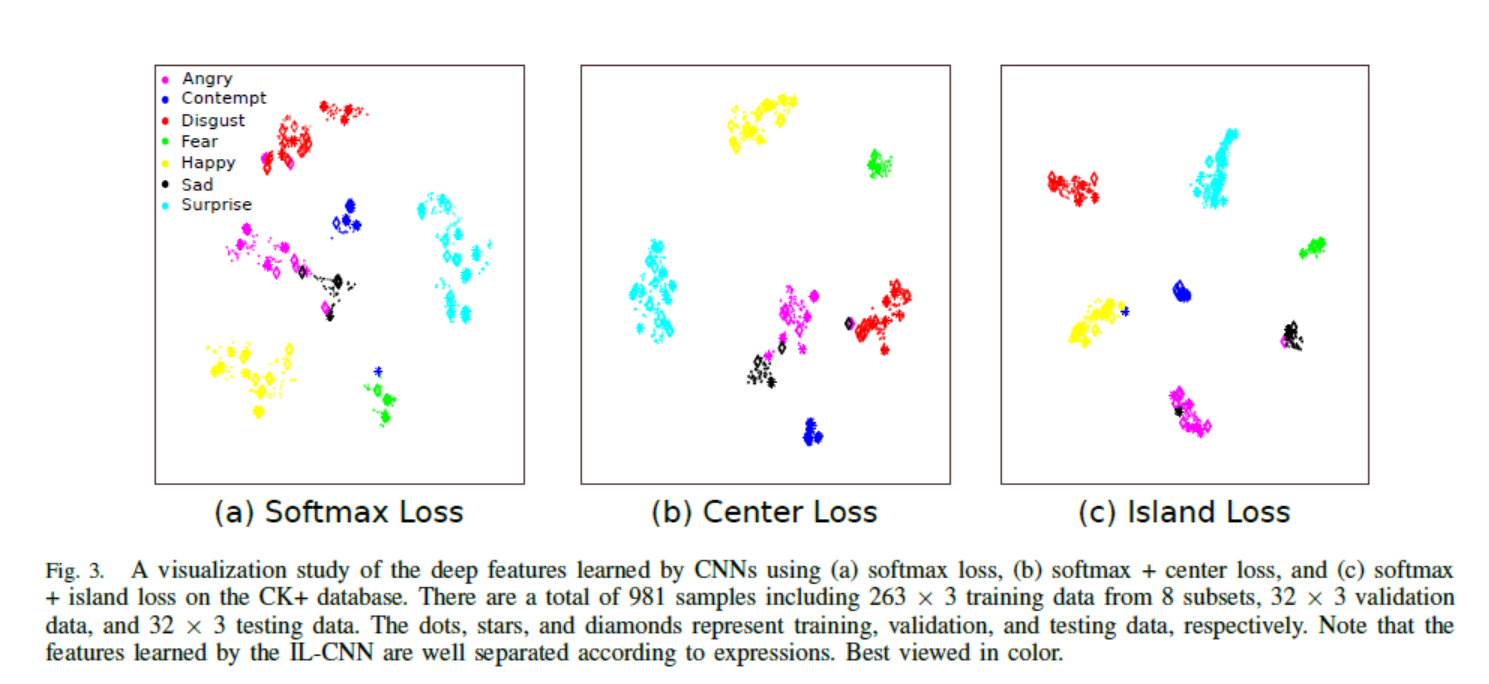
\[ 特徵視覺化 \]
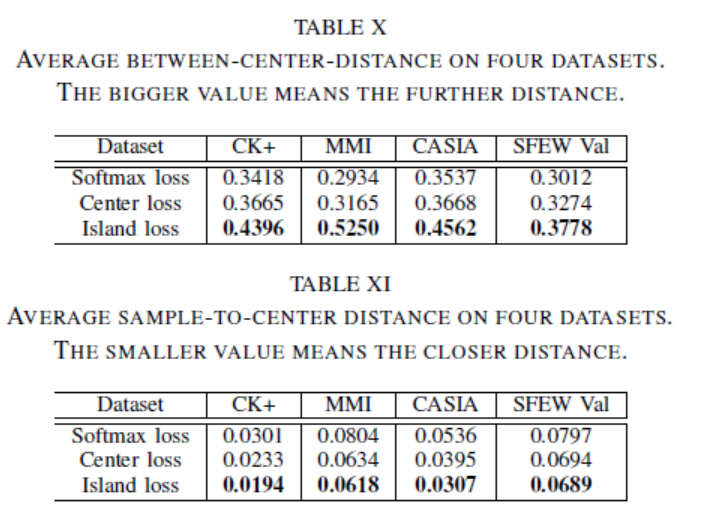
\[ 不同loss的類別距離 \]
CK+: 7表情94.35%
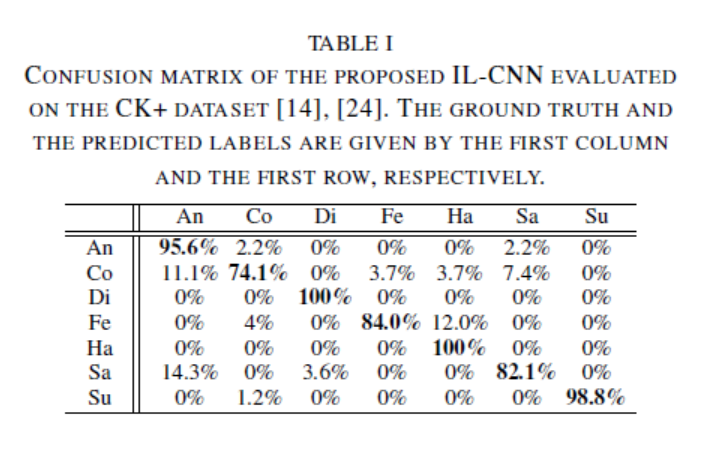
\[ ck+資料庫上islandloss混淆矩陣 \]
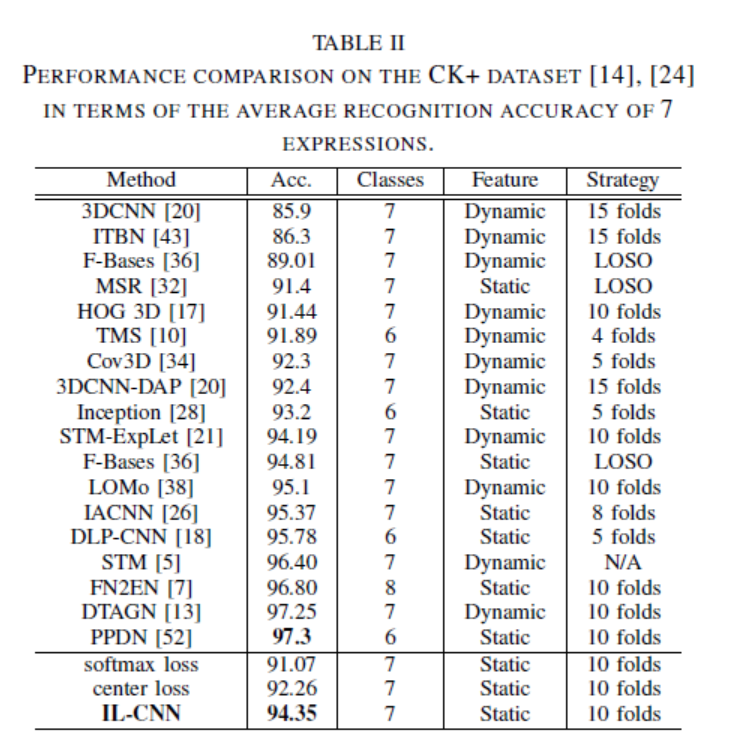
\[ ck+資料庫上不同演算法準確率對比 \]
MMI:6表情70.67%
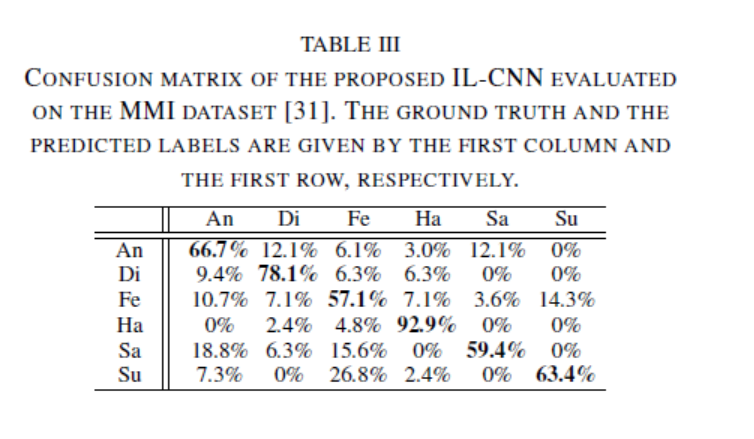
\[ MMI資料庫上islandloss混淆矩陣 \]

\[ MMI資料庫上不同演算法準確率對比 \]
- Ouli-CASIA: 6表情77.29%

\[ Oulu-CASIA資料庫上islandloss混淆矩陣 \]
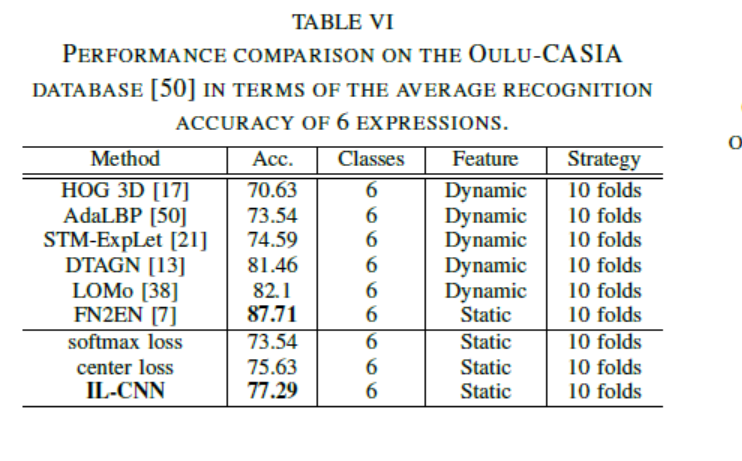
\[ Oulu-CASIA資料庫上不同演算法準確率對比 \]
- SFEW: 驗證集52.52% 測試集 59.41%
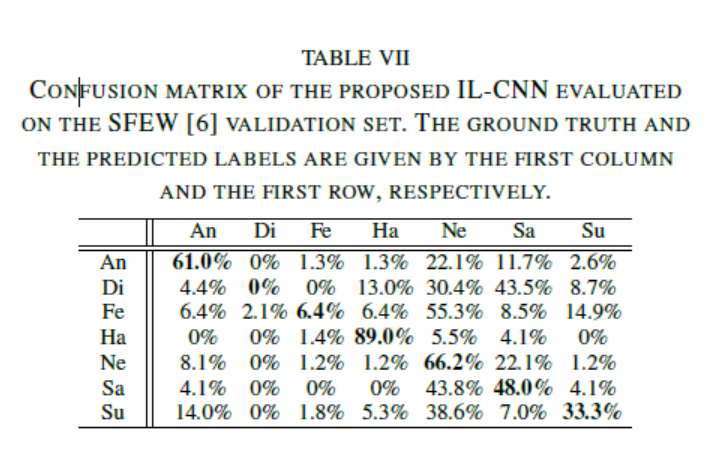
\[ SFEW資料庫驗證集上islandloss混淆矩陣 \]

\[ SFEW資料庫測試集上islandloss混淆矩陣 \]
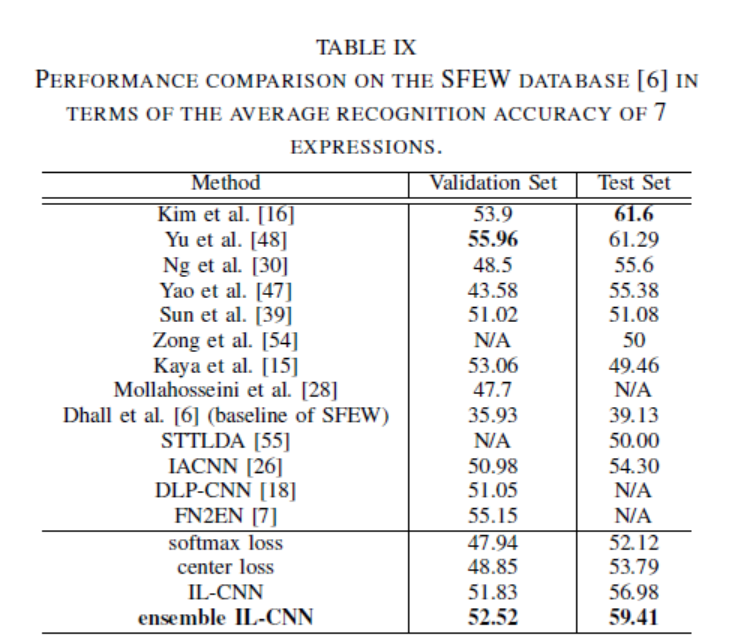
\[ SFEW資料庫不同演算法準確率對比 \]
總結
emmmmm,作者在centerloss的啟發下,提出了softmax,並且以餘弦距離衡量類間分佈,相比於centerloss和傳統的softmaxloss確實有提高,在網路上,bn或許對網路的效能有損失,而且具體的引數 \(\lambda\)也不好把握,小類別可以嘗試。
本文作者: 張峰
本文連結: http://www.enjoyai.site/2018/01/08/
版權宣告: 本部落格所有文章,均採用 CC BY-NC-SA 3.0 許可協議。轉載請註明出處!
相關推薦
Paper-[arXiv 1710.03144]Island Loss for Learning Discriminative Features in Facial Expression
[arXiv 1710.03144]Island Loss for Learning Discriminative Features in Facial Expression ABSTRACT 作者在CenterLoss的基礎上,提出了一個新的Loss,在關注類別的類內距離的同時,優化類間距離,使得每個類別擁
論文筆記(2)--(Re-ID) Learning Discriminative Features with Multiple Granularities for Person Re-Id
https://github.com/lwplw/re-id_mgn 本文的主要思想就是通過區域分割,來獲得不同粒度的特徵,比如全域性和區域性特徵以及更細粒度的區域性特徵,通過一個網路的不同分支得到這些特徵,每個分支都對不同的分割塊進行特徵提取。 論文提出通過融合行人的全域性資
The Top Books for Learning to Program in Python
Python is one of the most popular programming languages on the planet. It’s widely regarded as one of the best languages to learn first if you are
Method for video promo clips via facial expression tracking
But that hyper-short video format presents a challenge -- tackled by researchers from the University of Maryland, Netflix, Harvard Business School and San
part-aligned系列論文:1707.Deep Representation Learning with Part Loss for Person ReID 論文閱讀筆記
Deep Representation Learning with Part Loss for Person ReID 本論文為了更好的提升reid模型在未見過的行人影象判別能力,正對現有大部分只有全域性特徵表達(轉化為分類,一般minimize the em
[paper reading] C-MIL: Continuation Multiple Instance Learning for Weakly Supervised Object Detection CVPR2019
ppi ges cores sets spatial 完整 with rop ima MIL陷入局部最優,檢測到局部,無法完整的檢測到物體。將instance劃分為空間相關和類別相關的子集。在這些子集中定義一系列平滑的損失近似代替原損失函數,優化這些平滑損失。 C-MIL
Roomblock: a Platform for Learning ROS Navigation With Roomba, Raspberry Pi and RPLIDAR(轉)
include lan ini sea more ike res base package What is this? "Roomblock" is a robot platform consists of a Roo
Focal Loss for Dense Object Detection 論文閱讀
因此 分類 技術分享 模型 出發點 oss oca 圖片 同時 何凱明大佬 ICCV 2017 best student paper 作者提出focal loss的出發點也是希望one-stage detector可以達到two-stage detector的準確率,同時
論文閱讀筆記《The Contextual Loss for Image Transformation with Non-Aligned Data》(ECCV2018 oral)
github 區域 偏移 org nbsp 修改 transfer style 但是 目錄: 相關鏈接 方法亮點 相關工作 方法細節 實驗結果 總結與收獲 相關鏈接 論文:https://arxiv.org/abs/1803.02077 代碼:https://
【Paper】Deep & Cross Network for Ad Click Predictions
目錄 背景 相關工作 主要貢獻 核心思想 Embedding和Stacking層 交叉網路(Cross Network) 深度網路(Deep Network) 組合層(Combination Layer) 理論分析 多項式近似
Wasserstein CNN: Learning Invariant Features for NIR-VIS Face Recognition
表現 ted diff 差異 osi asi nta measure mod 承接上上篇博客,在其基礎上,加入了Wasserstein distance和correlation prior 。其他相關工作、網絡細節(maxout operator)、訓練方式和數據處理等基本
論文筆記:Learning Region Features for Object Detection
中心思想 繼Relation Network實現可學習的nms之後,MSRA的大佬們覺得目標檢測器依然不夠fully learnable,這篇文章類似之前的Deformable ROI Pooling,主要在ROI特徵的組織上做文章,文章總結了現有的各種ROI Pooling變體,提出了一個統一的數學表示式
Focal Loss for Dense Object Detection
Focal loss是Kaiming He和RBG發表在ICCV2017上的文章。 abstract: one-stage網路和two-stage網路相比,one-stage會得到大量目標位置。one stage不好的原因在於: 極度不平衡的正負樣本比例:abchor近
[論文筆記] Focal Loss for Dense Object Detection
Introduction 在 object detection 中,one-stage 跟 two-stage 的 model 的精準度的比較往往是一個高度討論的熱門話題,本論文中大致的描述了自己對於 two-stage 精準度上較高原因提出了一些猜測,詳細的
On Loss Functions for Deep Neural Networks in Classification讀後感
分類問題中的另一類loss函式 In particular, for purely accuracy focused research, squared hinge loss seems to be a better choice at it converge
Multi-attribute Learning for Pedestrian Attribute Recognition in Surveillance Scenarios
1 簡介 自然場景下的屬性識別,如人臉識別、目標識別,已經取得了良好的識別效果。但是,監控場景下影象解析度小、模糊,包含大的姿勢和光線變化,識別效果並不理想。 作者提出使用CNN模型進行行人屬性識別。 核心點: 使用卷積神經網路(CNN)進行特徵提取; 設計
Songbird data yields new theory for learning sensorimotor skills: Mathematical models describes distribution of sensory errors
During such trial-and-error processes of sensorimotor learning, a bird remembers not just the best possible command, but a whole suite of possibilities, s
Ask HN: What is your approach/plan for learning something totally new?
Suppose you are trying to improve/learn French Scrabble and French is not your first language. Or you are learning to play Go - or Sanskrit. Lets consider
Learning what life in Japan is like for people with disabilities
One recent Sunday, 7-year-old Yukito Takanashi of Tokyo was dribbling a soccer ball on a makeshift field. At one point, he put on an eye mask, just like bl
Ask HN: Egghead.io for learning CS
I'm a big fan of egghead.io for learning. However, it focuses on tools, frameworks and languages (mostly web dev) but not on practical implementation of CS
